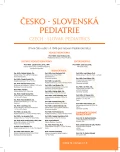Quality of life of pediatric patients with haemophilia in the Czech Republic – experiences of one centre
Authors:
V. Komrska 1; P. Ovesná 2; E. Zápotocká 1; V. Čepeláková 1; J. Blatný 3
Authors‘ workplace:
Klinika dětské hematologie a onkologie 2. LF UK a FN Motol, Praha
1; Institut biostatistiky a analýz, Lékařská fakulta Masarykovy univerzity, Brno
2; Oddělení dětské hematologie, FN Brno a Lékařská fakulta Masarykovy univerzity, Brno
3
Published in:
Čes-slov Pediat 2017; 72 (3): 154-159.
Category:
Overview
Aim of study:
The Czech National Haemophilia Programme is focusing not only on the health status and treatment of patients but also on the quality of their life. Examples of patients of our Comprehensive Care Center (CCC) demonstrate how the patients themselves evaluate their health status and quality of life.
Methods and results:
183 questionnaires focusing on quality of life of 72 pediatric patients with haemophilia and 3 with Von Willebrand disease were collected. For small children the questionnaires were filled out by their parents, school children and older patients filled them out themselves. The highest percentage of questionnaires were filled out by children of age between 12–14 years (22.9%) roughly 15% were done by age groups of 5–7, 15–17 and above 18 years the rest of age groups were negligible. 80.4% of questionnaires were filled out by boys with Haemophilia A the rest by patients with Haemophilia B and VWD. 58.7% of questionnaires were filled out by patients with severe type of Haemophilia. 42.5% were filled out by boys on permanent prophylactic treatment, 49.7% of questionnaires by boys with moderate and mild type of Haemophilia and on demand treatment. 3.9% of questionnaires were filled out by patients with inhibitor. 14 questionnaires from patients with temporary prophylactic treatment were excluded from analysis as a group difficult to evaluate. Therefore the total number of questionnaires was 165. Responses were evaluated in 3 ways: percentage representation of respective responses, transformation of responses into numeric scale of 0–100 (the higher value the better health condition) and percentiles.
Followed parameters of quality of life are rated in patients without inhibitor on numeric scale between 75–95 i.e. very positively. In a small group of patients with inhibitor the evaluation is significantly worse and oscillates between 30 (sense of physical health) and 95 (satisfaction with treatment).
Conclusion:
Presented data show that availability of good quality substitution treatment, long term prophylaxis, home treatment and complex care for pediatric patients with Haemophilia in specialized centers brings positive results which are reflected also in positive evaluation of quality of life by patients themselves.
Key words:
haemophilia, von Willebrand disease, quality of life, QoL Questionnaire, A36 hemofilia – QoL, Czech National Haemophilia Programme
Sources
1. St-Louis J, Urajnik DJ, Ménard F, et al. Generic and disease-specific quality of life among youth and young men with hemophilia in Canada. BMC Hematol 2016 May 5; 16: 13.
2. Oladapo AO, Epstein JD, Williams E, et al. Health-related quality of life assessment in haemophilia patients on prophylaxis therapy: a systematic review of results from prospective clinical trials. Haemophilia 2015 Sep; 21 (5): e344–358.
3. Santagostino E, Lentz SR, Busk AK, et al. Assessment of the impact of treatment on quality of life of patients with haemophilia A at different ages: insights from two clinical trials on turoctocog alfa. Haemophilia 2014 Jul; 20 (4): 527–534.
4. Chowdary P, Kearney S, Regnault A, et al. Improvement in health-related quality of life in patients with haemophilia B treated with nonacog beta pegol, a new extended half life recombinant FIX product. Haemophilia 2016 Jul; 22 (4): e267–274.
5. Aznar JA, García-Dasí M, Pérez-Alenda S, et al. Secondary prophylaxis vs. on-demand treatment to improve quality of life in severe adult haemophilia A patients: a prospective study in a single centre. Vox Sang 2014 Jan; 106 (1): 68–74.
6. Williams VK, Antoniou G, Jackson A, et al. Parents´ perception of quality of life in their sons with haemophilia. J Pediatr Child Health 2016 Dec; 52 (12): 1095–1098.
7. Lock J, Raat H, Peters M, et al. Optimization of home treatment in haemophilia: effects of transmural support by a haemophilia nurse on adherence and quality of life. Haemophilia 2016 Nov; 22 (6): 841–851.
8. Neufeld EJ, Recht M, Sabio H, et al. Effect of acute bleeding on daily quality of life assessments in patients with congenital hemophilia with inhibitors and their families: observations from the dosing observational study in hemophilia. Value Health 2012 Sep-Oct; 15 (6): 916–925.
9. Dekoven M, Wisniewski T, Petrilla A, et al. Health-related quality of life in haemophilia patients with inhibitors and their caregivers. Haemophilia 2013 Mar; 19 (2): 287–293.
Labels
Neonatology Paediatrics General practitioner for children and adolescentsArticle was published in
Czech-Slovak Pediatrics

2017 Issue 3
- What Effect Can Be Expected from Limosilactobacillus reuteri in Mucositis and Peri-Implantitis?
- The Importance of Limosilactobacillus reuteri in Administration to Diabetics with Gingivitis
Most read in this issue
- Patello-femoral disorders in children
- Legg-Calve-Perthes disease
- Pepsin in secretion from the upper respiratory tract as a marker of extraesophageal reflux in children
- RSV infection in late preterm infants
